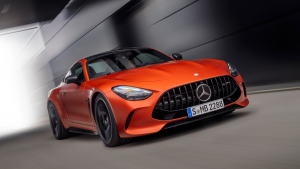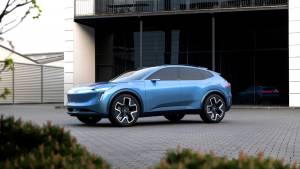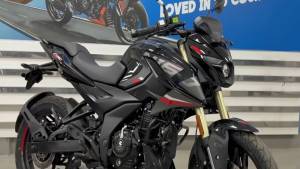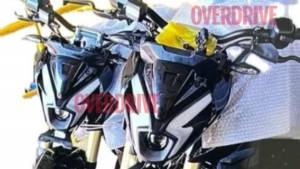Stefan Pierer on KTM's future plans
Here are the excerpts from the interview between CNBC-TV18 and KTM CEO Stefan Pierer
Q: Let me start by asking you about how the year has gone by for you? It is looking very strong despite the fact that we have seen tough times in Europe, you have managed to beat expectations, you have grown it over 30 percent for the month of October and you are targeting 100,000 units in terms of the number of units you will be able to sell in 2012. Are you on track to meet that?
A: We are precisely on track. It is becoming the best year ever in KTM and we are touching 100,000 units. We are exceeding it a little bit and it may be around 105-106,000 units by the end of this year. The sale is around Euro 610, a very good result. Despite the situation in Europe being particularly bad, the markets can be read throughout the year. The US is bouncing back and the big growth rate is coming from Asia, Southeast Asia and especially India.
Q: You talked about how growth is coming from emerging markets like India. Would you have been able to do the 100,000 mark without the alliance with Bajaj? Has Bajaj in that sense really been the growth driver for KTM when it comes to volumes?
A: Yes absolutely. Never ever would we have got this chance to sell motorcycles in these areas without the alliance with Bajaj. Due to our alliance with Bajaj we can combine the technology of KTM with very cost efficient mass production techniques of Bajaj. Therefore, we could create entrance bikes, small displacement bikes and real KTMs for a competitive price.
Q: What has been the experience now? This partnership has been on since 2007, you are actually manufacturing here in India and you are now selling in India, you are also exporting from India to the rest of the world. In terms of value engineering, in terms of how you can actually bring cost down and in terms of development and design because you are working very closely with the Bajaj team, what is the experience like?
A: It started more than five years ago. There was the first meeting with Rajiv Bajaj. In the first meeting itself the chemistry worked very well. We appreciate each other and we built up a really strong trust base. Based on that personal relationship to bring the strengths of the company together, including the CEOs, the R&D people, production and quality people, they like to come to India and vice versa like to work together.
Q: But it is hard right? CEOs interacting with each other is one thing but, getting two R&D teams to actually work together towards one common shared vision, one common goal, perhaps couldn't have been that easy. How have you been able to coordinate and collaborate?
A: First of all you should be a little patient. It doesn't come overnight. It is hard work to convince people on both sides. But on the top level, management level there is not a big difference between the Bajaj Group and KTM. There is not much difference between India and Austria. In terms of quantity there is a huge difference and also in some system development issues. But, we have taken the best of both sides and we are doing a great job together.
Q: Bajaj now holds about 47 percent in KTM, they have been upping their stake in the company, you continue to be the largest shareholder and the major control rests with you. Could there be the possibility of that changing or becoming a more equal partnership in terms of shareholding?
A: Rajiv Bajaj and I have agreed that based on the situation right now, we are proceeding for the next couple of years and trying to work out as much as it is possible on common projects, on common motorcycles and even on common export markets. Then let's see what happens.
Q: So you are not willing to give up majority control just yet?
A: Because it is a personality driven business, as a brand KTM stays ready to race. We like competition and that needs one man who is in the front. That's the thing and I am an entrepreneur. I like that and I would take all the responsibility and I like to work with Rajiv.
Q: Speaking of working together you are not part of a tripartite alliance in that sense because there is KTM, Kawasaki and Bajaj as part of the global alliance that Bajaj is structured together with. How do you benefit from it and how do you actually leverage this tripartite agreement?
A: Kawasaki doesn't interfere the relationship between Bajaj and KTM because first Bajaj has a long-term relationship with Kawasaki and we knew that Kawasaki has a certain alliance.
Q: Could you leverage that relationship?
A: Anyway, the Japanese brands are my favourite competitors because while I am the world market leader in respect of competition, I had to overtake all the Japanese. In this segment, Kawasaki is my most liked competitor because the brand content is a little bit similar and they are very good in racing. I like the competition.
Q: So you had no apprehensions about the coming together of this alliance?
A: No. As a competitor you have to do a fair play and the better one wins and that's the story.
Q: I understand that your competitors have actually been at your headquarters visiting you. What is happening as far as the global pecking order is concerned? I understand it is likely to be a photo finish between you and BMW this year or perhaps next year?
A: Quantity wise this year could be a photo finish one. We are coming close to one hundred and six thousand, let's see what the units are telling us at that end. Regarding the Japanese competitors, I have huge respect for Japanese companies.
I have been working for 20 years in the motorcycle industry, I have learned a lot from the Japanese and that is the reason I have huge respect. Obviously, it is the others and also the big competitors who are respecting. Meanwhile, the KTM is a very successful player.
Q: Are they watching closely this alliance that you have been able to structure with Bajaj, is that the reason for all their interest in KTM now?
A: That's a part of our success. For sure, that's one of the main reasons because the alliance between Bajaj and KTM is a mix of high technology with a cost efficient production structure. That could create a power house in the future of the two-wheeler industry.
Q: Do you think you have started a trend because there have been conversations between BMW and TVS, if one is given to believe what one hears at this point in time? Do you believe that the Bajaj-KTM alliance in a sense has started perhaps a trend of actually seeing companies like BMW and other global motorcycle brands tying up with an Indian partner?
A: We have created this trend and it is not unusual that somebody is doing a very successful thing and others are starting to copy it. I think it is part of the business.
Q: So, what have you heard? Is BMW going to tie up with TVS?
A: I have heard about it and it is well-known. It is not the same as Bajaj and KTM because it is always based on the relationship between the main decision makers. The culture must be a little similar. If you have a huge group like a car manufacturer and a small little company, let's see what's coming up.
Q: Speaking of what is expected from this alliance now, you launched the KTM Duke in India, it has met with a lot of success, what about the 125cc because that is being exported from here to Europe. It has done extremely well for you and is largely responsible for the kind of volume growth that you have seen. Are we likely to see that in India anytime soon or is it too close to the Pulsar territory?
A: The 125cc is a very specific displacement for the European market because that is more or less the moped class. You can ride it at the age of 16 and that's a very European style. For India, I can expect 180cc, 190cc and not a 125cc. We expect additional displacements, the 390cc is coming which is a full faired version and the so called tour purpose version. By the end, we have a full model range where we can settle in all these and especially the Asian markets.
Q: Would the priority though for the Indian market at this point be at the higher end as opposed to the lower end displacement?
A: We will focus more on the higher end, especially keeping the brand content of KTM very sharp. That means it is ready to race and it is always the best performing engine. It is a very good design which looks different to the others, that's our style of selling motorcycles and we are not up to the Indian situation, but we still want to target higher growth.
Q: How soon can we see the next KTM-Bajaj launch for India?
A: Next, we expect a full faired 390cc and may be a 200cc motorcycle. We are also thinking to make one step lower, below 200 cc, 180cc or 190cc to make more price competitive models. There are so many units
Q: What is the timeline that we are talking of?
A: We are talking about somewhere between 12 to 18 months. Every six months something will come.
Q: The common platform approach that you have adopted, which is working very well for this alliance is something that others are beginning to talk about as well. What has been the big learning for you as far as this common platform approach is concerned?
A: What I have learnt from Bajaj is to look very specifically on every detail, to see that the usage of the part is maximum across different platforms. As a high performance manufacturer, you are always looking at the best highest performance and sometimes losing a little bit to cost efficiency. So, that was the learning from this side where we are benefiting very much. Fortunately, when we decided to make the engine platforms, we were the first. We recognized after the outcome of the crisis that we are facing issues worldwide, especially in Europe. The power two-wheeler is becoming a commuting and transportation item in Europe again. The displacement between 125cc up to 400cc will come in the future as a common transportation item.
Q: When we talk about value engineering, that impacts margins significantly as well. What kind of margins are you likely to enjoy given the fact that you now have this alliance which is working very well and something that you can leverage on?
A: The biggest advantage for KTM is that still we are selling 10000 units. For a model, it is outstanding, but for Indian circumstances it is nothing. To achieve a competitive price level we are sharing the platform. The same platform is used in Pulsar which has 10-15 times the quantity and that's the big benefit for KTM. On the other hand, the technology what we brought in gives the Pulsar the capacity to compete successfully against Japanese competition.
Q: Specifically about the Indian market, I understand you have sold about 9000 odd of the KTM in India this year. What is the expectation now given the fact that we are going to see more launches as well from you?
A: We can reach 10 times the size that we have right now. As far as I have learnt, it is a very price sensitive market. If we can offer three different models and we can offer several displacements, why not sell 8000.
Q: What is the target that you are working with for instance for 2013?
A: For 2013 we expect around 35000 units coming out of the production in Pune which is spread out in all the emerging markets, in Europe and including India. But what is my vision? It is a clear vision. Within the next 3-4 years, I want to have 100,000 coming from the Pune production of Bajaj.
Q: Hopefully, 100,000 units split equally between export market and the domestic market here?
A: That's obviously the outcome then. For KTM as a whole, it means 100,000 produces in Austria, high performance, off road and on road models and 100,000 units are coming from Pune.
Q: In terms of new markets that you will be looking at, Thailand, Indonesia, how soon can we expect you foraying into them through this alliance?
A: We have already setup a Complete Knock Down (CKD) operation in Malaysia together with Bajaj. We have partnered a local Malaysian partner for that and it is already in place. We have already sent around 3000 units there. From Malaysia it is possible to serve Thailand as well. We just have to setup our own marketing and sales subsidiary in Singapore as the centre. Indonesia is doing very well. So, we are already there on a small scale but, within 2 to 3 years we will have significant numbers.
Q: You are sitting in India and it is inevitable whenever you talk India, you talk China as well. Any plans to look at China?
A: In China I am very careful because for me the culture doesn't fit with my culture. So, as a race brand I want to win. If you go to China, you can just get the second place and that's not what I like.
Q: Speaking of a second place and coming back to the question on your battle with BMW, the Husqvarna acquisition, how are you looking at that and do you think it is going to make a big difference as far as your photo finish with BMW is concerned?
A: If you are running several brands within a group it is more difficult compared to a single brand company like KTM. For us it is much easier coming from off-road and going on-road because we are focusing on one brand. If you are splitting your resources in different brands, it is difficult. Especially if you don't have the close linkage to that segment, to that customer then you are struggling.
Q: So, do you believe Husqvarna may be on the block, up for sale again anytime soon?
A: Anything can happen.
Q: Wouldn't you be a buyer if that were to be the case?
A: Based on our market share, we have to think about it. It's a European brand, it's a Scandinavian brand. We still have a brand in our group, it is unknown outside of Europe. It is the former spin-off of Husqvarna when Husqvarna was sold in the late 80s. They had created this spin-off. We bought that company in 1994. Meanwhile, this was integrated in KTM with a different styling with a different colour, but using a lot of platform components and therefore, it is very successful. It is already half the size of Husqvarna.
Q: What about the US because that has been a difficult market for you. How is growth looking like in the US and in Canada for you at this point in time?
A: Traditionally, US was always one of our best markets. In US we are already bigger than BMW for the last 20 years. The American market went down dramatically from 2008 to 2009. However, for the last one year or so it is a very stable ground and now it is starting to slightly go up in single digit. We lost 50 percent of the volume, but it is going up. In US, printed money is flowing to the retail financing and as any American gets a credit he buys it. Hence, it is positive.
Q: Things are looking better?
A: Yes it is looking better, from a different level but it is certainly looking better. We are doing very well. We have a blast of almost 25 per cent compared to last year. It is based on several things, new models, dollar and the currency rate is a key. US therefore, is currently one of the backbones of our markets around the world.
Q: In general, it has been a better year for European manufacturers, has it not because you, BMW, Ducati are doing better than Harley or even the Japanese? Why would you think that has happened?
A: Harley is not doing bad. We shouldn't underrate Harley as a big motorcycle producer in that specific segment. It is by far the market leader in the Cruiser segment. It is doing well, but brands which have focused very sharply throughout the crisis on delivering content and good products have benefited out of the crisis. For us, we didn't stop development. We had an alliance with Bajaj, we were pushing it despite the very tough time in 2009. We were pushing with other developments also. With new models you can get out of the crisis.
Q: This seems to be avery clear understanding between you and Bajaj that at the backend you may share a common platform, but at the frontend they are two very distinct brands and they are going to be managed very differently as well. That perhaps is one of the attributes of the success of your strategy.
A: Yes. It didn't mix up. We were discussing very often whether we can we use double branding, this and that, but it is clear that KTM should stay very sharp and very clear. The Pulsar has a clear profile and it shouldn't be mixed up. We think we have all the instruments to compete very successfully globally against Japanese brands.
Q: The next time you are going to be here in India, are you going to be at the launch of the 180cc, 190cc or the 390cc?
A: I always like to come to India. It doesn't matter which model we are launching. For sure, the next plan is full faired.
Check KTM's India-specific plans here
Related Stories
Top Stories
Latest Videos
Most Popular
- Budget Sportbike Showdown: Kawasaki Ninja 500 vs Aprilia RS 457 vs Yamaha YZF-R3
- 2014 Triumph Daytona 675 vs 2024 Kawasaki ZX6R - A Decade of Evolution in Supersport Motorcycles
- Mumbai-Pune Expressway speed restrictions updated
- Nissan Magnite EZ-Shift review - is the AMT any good?
- Nitin Gadkari states that tax on Hybrids should be reduced to 12 percent in the coming future














